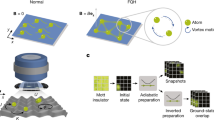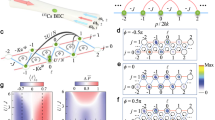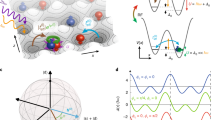Abstract
The interplay between magnetic fields and interacting particles can lead to exotic phases of matter that exhibit topological order and high degrees of spatial entanglement1. Although these phases were discovered in a solid-state setting2,3, recent innovations in systems of ultracold neutral atoms—uncharged atoms that do not naturally experience a Lorentz force—allow the synthesis of artificial magnetic, or gauge, fields4,5,6,7,8,9,10. This experimental platform holds promise for exploring exotic physics in fractional quantum Hall systems, owing to the microscopic control and precision that is achievable in cold-atom systems11,12. However, so far these experiments have mostly explored the regime of weak interactions, which precludes access to correlated many-body states4,13,14,15,16,17. Here, through microscopic atomic control and detection, we demonstrate the controlled incorporation of strong interactions into a two-body system with a chiral band structure. We observe and explain the way in which interparticle interactions induce chirality in the propagation dynamics of particles in a ladder-like, real-space lattice governed by the interacting Harper–Hofstadter model, which describes lattice-confined, coherently mobile particles in the presence of a magnetic field18. We use a bottom-up strategy to prepare interacting chiral quantum states, thus circumventing the challenges of a top-down approach that begins with a many-body system, the size of which can hinder the preparation of controlled states. Our experimental platform combines all of the necessary components for investigating highly entangled topological states, and our observations provide a benchmark for future experiments in the fractional quantum Hall regime.
This is a preview of subscription content, access via your institution
Access options
Access Nature and 54 other Nature Portfolio journals
Get Nature+, our best-value online-access subscription
$29.99 / 30 days
cancel any time
Subscribe to this journal
Receive 51 print issues and online access
$199.00 per year
only $3.90 per issue
Buy this article
- Purchase on Springer Link
- Instant access to full article PDF
Prices may be subject to local taxes which are calculated during checkout





Similar content being viewed by others
References
Chen, X., Gu, Z.-C. & Wen, X.-G. Local unitary transformation, long-range quantum entanglement, wave function renormalization, and topological order. Phys. Rev. B 82, 155138 (2010)
Tsui, D. C., Stormer, H. L. & Gossard, A. C. Two-dimensional magnetotransport in the extreme quantum limit. Phys. Rev. Lett. 48, 1559–1562 (1982)
Laughlin, R. B. Anomalous quantum Hall effect: an incompressible quantum fluid with fractionally charged excitations. Phys. Rev. Lett. 50, 1395–1398 (1983)
Schweikhard, V., Coddington, I., Engels, P., Mogendorff, V. P. & Cornell, E. A. Rapidly rotating Bose-Einstein condensates in and near the lowest Landau level. Phys. Rev. Lett. 92, 040404 (2004)
Lignier, H. et al. Dynamical control of matter-wave tunneling in periodic potentials. Phys. Rev. Lett. 99, 220403 (2007)
Jaksch, D. & Zoller, P. Creation of effective magnetic fields in optical lattices: the Hofstadter butterfly for cold neutral atoms. New J. Phys. 5, 56 (2003)
Kolovsky, A. R. Creating artificial magnetic fields for cold atoms by photon-assisted tunneling. Europhys. Lett. 93, 20003 (2011)
Lin, Y.-J., Compton, R. L., Jiménez-Garca, K., Porto, J. V. & Spielman, I. B. Synthetic magnetic fields for ultracold neutral atoms. Nature 462, 628–632 (2009)
An, F. A., Meier, E. J. & Gadway, B. Direct observation of chiral currents and magnetic reflection in atomic flux lattices. Sci. Adv. 3, e1602685 (2017)
Kolkowitz, S. et al. Spin–orbit-coupled fermions in an optical lattice clock. Nature 542, 66–70 (2017)
Hafezi, M., Sørensen, A. S., Demler, E. & Lukin, M. D. Fractional quantum Hall effect in optical lattices. Phys. Rev. A 76, 023613 (2007)
Gemelke, N., Sarajlic, E. & Chu, S. Rotating few-body atomic systems in the fractional quantum Hall regime. Preprint at https://arxiv.org/abs/1007.2677 (2010)
Jotzu, G. et al. Experimental realization of the topological Haldane model with ultracold fermions. Nature 515, 237–240 (2014)
Stuhl, B. K., Lu, H.-I., Aycock, L. M., Genkina, D. & Spielman, I. B. Visualizing edge states with an atomic Bose gas in the quantum Hall regime. Science 349, 1514–1518 (2015)
Mancini, M. et al. Observation of chiral edge states with neutral fermions in synthetic Hall ribbons. Science 349, 1510–1513 (2015)
Aidelsburger, M. et al. Realization of the Hofstadter Hamiltonian with ultracold atoms in optical lattices. Phys. Rev. Lett. 111, 185301 (2013)
Miyake, H., Siviloglou, G. A., Kennedy, C. J., Burton, W. C. & Ketterle, W. Realizing the Harper Hamiltonian with laser-assisted tunneling in optical lattices. Phys. Rev. Lett. 111, 185302 (2013)
Harper, P. G. Single band motion of conduction electrons in a uniform magnetic field. Proc. Phys. Soc. A 68, 874–878 (1955)
Hafezi, M., Mittal, S., Fan, J., Migdall, A. & Taylor, J. M. Imaging topological edge states in silicon photonics. Nat. Photon. 7, 1001–1005 (2013)
Leder, M. et al. Real-space imaging of a topologically protected edge state with ultracold atoms in an amplitude-chirped optical lattice. Nat. Commun. 7, 13112 (2016)
Celi, A. et al. Synthetic gauge fields in synthetic dimensions. Phys. Rev. Lett. 112, 043001 (2014)
Hügel, D. & Paredes, B. Chiral ladders and the edges of quantum Hall insulators. Phys. Rev. A 89, 023619 (2014)
Bakr, W. S., Gillen, J. I., Peng, A., Fölling, S. & Greiner, M. A quantum gas microscope for detecting single atoms in a Hubbard-regime optical lattice. Nature 462, 74–77 (2009)
Sherson, J. F. et al. Single-atom-resolved fluorescence imaging of an atomic Mott insulator. Nature 467, 68–72 (2010)
Dhar, A. et al. Bose-Hubbard model in a strong effective magnetic field: emergence of a chiral Mott insulator ground state. Phys. Rev. A 85, 041602 (2012)
Roushan, P. et al. Chiral ground-state currents of interacting photons in a synthetic magnetic field. Nat. Phys. 13, 146–151 (2017)
Zupancic, P. et al. Ultra-precise holographic beam shaping for microscopic quantum control. Opt. Express 24, 13881–13893 (2016)
Preiss, P. M. et al. Strongly correlated quantum walks in optical lattices. Science 347, 1229–1233 (2015)
He, Y.-C., Grusdt, F., Kaufman, A., Greiner, M. & Vishwanath, A. Realizing and Adiabatically Preparing Bosonic Integer and Fractional Quantum Hall states in Optical Lattices. Preprint at https://arxiv.org/abs/1703.00430 (2017)
Acknowledgements
We acknowledge conversations with M. Aidelsburger, I. Cirac, E. Demler, M. Endres, M. Foss-Feig, N. Gemelke, D. Greif, W. Ketterle, R. Ma, H. C. Po, J. Simon and A. Vishwanath. We are supported by grants from the National Science Foundation, the Gordon and Betty Moore Foundation’s EPiQS Initiative, an Air Force Office of Scientific Research MURI programme, an Army Research Office MURI programme and the NSF Graduate Research Fellowship Program (M.R.).
Author information
Authors and Affiliations
Contributions
M.E.T., A.L., M.R., R.S., P.M.P. and A.M.K. contributed to constructing the experiment, collecting and analysing the data, and writing the manuscript. F.G. and T.M. contributed to analysing the data and writing the manuscript. D.B. developed the short-time analytic result. M.G. supervised the work.
Corresponding author
Ethics declarations
Competing interests
The authors declare no competing financial interests.
Additional information
Reviewer Information Nature thanks L. LeBlanc and the other anonymous reviewer(s) for their contribution to the peer review of this work.
Publisher's note: Springer Nature remains neutral with regard to jurisdictional claims in published maps and institutional affiliations.
Supplementary information
Supplementary Information
This file contains Supplementary Text, Supplementary Figures 1-14 and Supplementary References. (PDF 4433 kb)
Rights and permissions
About this article
Cite this article
Tai, M., Lukin, A., Rispoli, M. et al. Microscopy of the interacting Harper–Hofstadter model in the two-body limit. Nature 546, 519–523 (2017). https://doi.org/10.1038/nature22811
Received:
Accepted:
Published:
Issue Date:
DOI: https://doi.org/10.1038/nature22811
This article is cited by
-
Realization of a fractional quantum Hall state with ultracold atoms
Nature (2023)
-
Observation of frustrated chiral dynamics in an interacting triangular flux ladder
Nature Communications (2023)
-
Observation-dependent suppression and enhancement of two-photon coincidences by tailored losses
Nature Photonics (2022)
-
Strain and pseudo-magnetic fields in optical lattices from density-assisted tunneling
Communications Physics (2022)
-
Atom-optically synthetic gauge fields for a noninteracting Bose gas
Light: Science & Applications (2022)
Comments
By submitting a comment you agree to abide by our Terms and Community Guidelines. If you find something abusive or that does not comply with our terms or guidelines please flag it as inappropriate.



